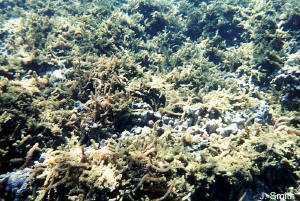|
Invasive Algae Home Red Algae Green Algae Brown Algae Seagrasses Glossary |
|
|||||||||
|
|
|||||||||
|
|||||||||
|
Click on pictures for larger images
Kappaphycus species are among the largest tropical red algae, with a high growth rate (can double in biomass in 15 to 30 days). It was thought until recently that their only method of dispersal was by vegetative fragmentation, which was thought to limit their expansion. Reproductive Kappaphycus has recently been found in Kane'ohe Bay.
Distribution of Kappaphycus spp. in Hawaiian Islands
Kappaphycus
alvarezii overgrowing Porites compressa in |
|
||||||||
|
Description Algae tough, fleshy, firm; up to 2 m tall. Thalli coarse, with axes and branches 1 - 2 cm diameter; heavy, with major axes relatively straight, lacking secondary branches near apices. Frequently and irregularly branched, most branches primary, secondary branches intercalated between primary branches or mostly lacking. Shiny green to yellow orange.
Morphologically plastic: variable thalli forms, from gnarled forms with few small branches in shallow areas to large, intricately tangled, fleshy mats in deeper waters.
Structural Features Reef flat and reef edge, 1 to 17 m deep. Loosely attached to broken coral, or unattached fragments floating in shallow and deep waters. Can form large, moving mats of unattached thalli.
Habitat Reef flat and reef edge, 1 to 17 m deep. Loosely attached to broken coral, or unattached fragments floating in shallow and deep waters. Can form large, moving mats of unattached thalli.
Distribution Hawai‘i: Kane‘ohe, O‘ahu.Mechanism of Introduction: Introduced to Kane‘ohe Bay in 1974 for commercial cultivation. Worldwide: Malaysia, Sulu sea, southern Philippines.
Ecology/Impact The two Kappaphycus species, K alvarezii and K. striatum, are some of the largest tropical red algae, with extremely high growth rates, doubling in 15-30 days. Since their introduction in Kaneohe Bay in 1974, they have spread at the rate of 260 m/yr. The high growth rate, plastic morphology, and extremely successful vegetative regeneration make the two Kappaphycus species potentially destructive invasives in Hawaiian waters.
Until recently in Hawaii Kappaphycus sp. have only recently was Kappaphycus species found to reproduce sexually. Since its introduction, observations and studies have reported reproduction by vegetative fragmentation. At the tip of each branch is a cluster of apical cells potentially high in regenerative capabilities that are able to regenerate a new thallus after breaking off. A broken tip can grow into full-sized thalli in a short period of time. This species has been highly successful at Kaneohe Bay, dominating the sandy spur and grooves on the reef flat. It inhabits barren sandy grooves where it does not appear to compete with native algal species. In other locations, K. alvarezii has been found to provide habitat for a diverse invertebrate population and reef fishes. This red alga was found to have a higher index of species diversity than neighboring reefs without the alien. It is highly grazed and can be found to be the primary food item in gut contents of common herbivorous fishes. The alga’s large growth form can be detrimental to corals by shadowing or smothering, thus causing coral death.
The red alga’s dispersal is thought to be constrained by size and weight, as it appears to become trapped in depressions and channels. The species is also constrained by high herbivory. K. alvarezii has managed to spread to neighboring reefs with supportive physical factors and little grazing, where it is dominating the changing marine ecology.
K. alvarezii has been introduced throughout the warm tropics for commercial cultivation. It is a major producer of kappa-carrageenan, which is used for medicinal purposes and as a homogenizer in milk products, toothpaste and jellies.
|
|||||||||
|
|
|
|
References Abbott, I.A., 1999. Marine Red Algae of the Hawaiian Islands. Bishop Museum Press, Honolulu, Hawai‘i. Rodgers, S.K, and E.F. Cox, 1999. Rate of spread of introduced rhodophytes Kappaphycus alvarezii, Kappaphycus striatum, and Gracilaria salicornia and their current distributions in Kane ‘ohe Bay, O‘ahu, Hawai‘i. Pacific Science 53: 232-241. Russell, D.J. 1983. Ecology of the imported red seaweed Eucheuma striatum Schmitz on Coconut Island, O‘ahu, Hawai‘i. Pacific Science 37: 87-107. Woo, M.M.L., 2000. Ecological impacts interactions of the introduced red alga, Kappaphycus striatum, in Kane‘ohe Bay, O‘ahu, Masters Thesis, University of Hawai‘i at Manoa, Honolulu, Hawai‘i. |
Web Pages
Ecological Success of Alien/Invasive Algae in Hawai‘i:
http://www.botany.hawaii.edu/GradStud/smith/websites/
Marine Invasives in Hawai‘i:
|


